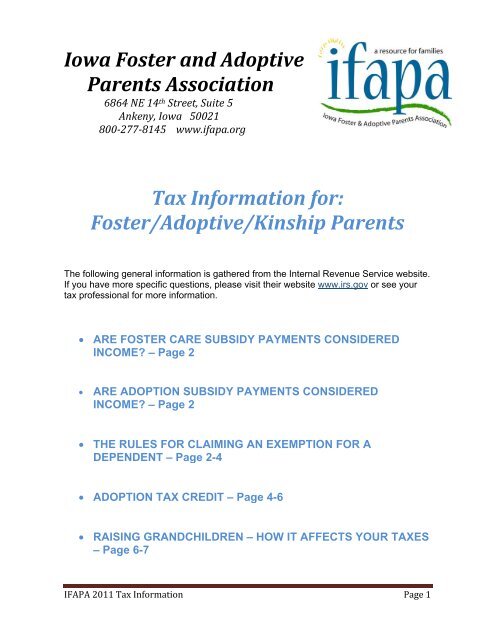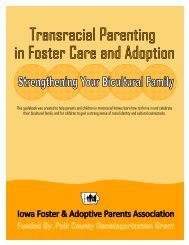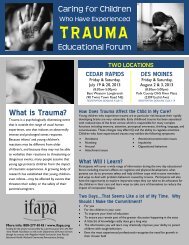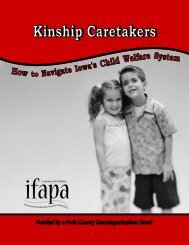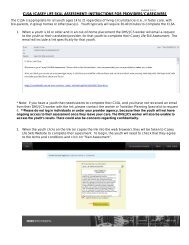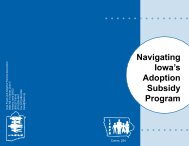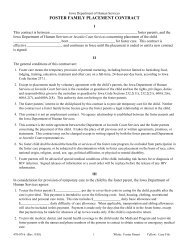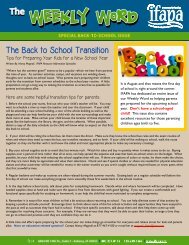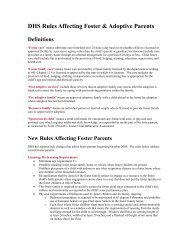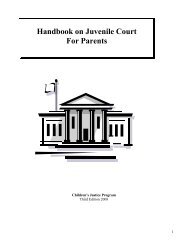Iowa Foster and Adoptive Parents Association Tax ... - ifapa
Iowa Foster and Adoptive Parents Association Tax ... - ifapa
Iowa Foster and Adoptive Parents Association Tax ... - ifapa
You also want an ePaper? Increase the reach of your titles
YUMPU automatically turns print PDFs into web optimized ePapers that Google loves.
<strong>Iowa</strong> <strong>Foster</strong> <strong>and</strong> <strong>Adoptive</strong><strong>Parents</strong> <strong>Association</strong>6864 NE 14 th Street, Suite 5Ankeny, <strong>Iowa</strong> 50021800‐277‐8145 www.<strong>ifapa</strong>.org<strong>Tax</strong> Information for:<strong>Foster</strong>/<strong>Adoptive</strong>/Kinship <strong>Parents</strong>The following general information is gathered from the Internal Revenue Service website.If you have more specific questions, please visit their website www.irs.gov or see yourtax professional for more information. ARE FOSTER CARE SUBSIDY PAYMENTS CONSIDEREDINCOME? – Page 2ARE ADOPTION SUBSIDY PAYMENTS CONSIDEREDINCOME? – Page 2 THE RULES FOR CLAIMING AN EXEMPTION FOR ADEPENDENT – Page 2-4 ADOPTION TAX CREDIT – Page 4-6 RAISING GRANDCHILDREN – HOW IT AFFECTS YOUR TAXES– Page 6-7IFAPA 2011 <strong>Tax</strong> Information Page 1
ARE FOSTER CARE SUBSIDY PAYMENTS CONSIDERED INCOME?<strong>Foster</strong> care providers. Payments you receive from a state, political subdivision, or a qualified foster careplacement agency for providing care to qualified foster individuals in your home generally are not included in yourincome. However, you must include in your income payments received for the care of more than 5 individuals age19 or older <strong>and</strong> certain difficulty-of-care payments.A qualified foster individual is a person who:1. Is living in a foster family home, <strong>and</strong>2. Was placed there by:a. An agency of a state or one of its political subdivisions, orb. A qualified foster care placement agency.Difficulty-of-care payments. These are additional payments that are designated by the payer as compensationfor providing the additional care that is required for physically, mentally, or emotionally h<strong>and</strong>icapped qualifiedfoster individuals. A state must determine that the additional compensation is needed, <strong>and</strong> the care for which thepayments are made must be provided in your home.You must include in your income difficulty-of-care payments received for more than:10 qualified foster individuals under age 19, or5 qualified foster individuals age 19 or older.Maintaining space in home. If you are paid to maintain space in your home for emergency foster care, youmust include the payment in your income.ARE ADOPTION SUBSIDY PAYMENTS CONSIDERED INCOME?Payments you receive from a state or a government child welfare agency for adoption assistance payments <strong>and</strong>related subsidies for adopted children, are not included in your taxable income.OVERVIEW FOR CLAIMING AN EXEMPTION FOR A DEPENDENTCaution. This table is only an overview of the rules.You cannot claim any dependents if you, or your spouse if filing jointly, could be claimed as a dependentby another taxpayer.You cannot claim a married person who files a joint return as a dependent unless that joint return is onlya claim for refund <strong>and</strong> there would be no tax liability for either spouse on separate returns.You cannot claim a person as a dependent unless that person is a U.S. citizen, U.S. resident alien, U.S.national, or a resident of Canada or Mexico. 1You cannot claim a person as a dependent unless that person is your qualifying child or qualifyingrelative.IFAPA 2011 <strong>Tax</strong> Information Page 2
School defined. A school can be an elementary school, junior or senior high school, college, university, ortechnical, trade, or mechanical school. However, an on-the-job training course, correspondence school, or schooloffering courses only through the Internet does not count as a school.Vocational high school students. Students who work on “co-op” jobs in private industry as a part of a school'sregular course of classroom <strong>and</strong> practical training are considered full-time students.Permanently <strong>and</strong> totally disabled. Your child is permanently <strong>and</strong> totally disabled if both of the following apply.He or she cannot engage in any substantial gainful activity because of a physical or mental condition.A doctor determines the condition has lasted or can be expected to last continuously for at least a yearor can lead to death.Residency TestTo meet this test, your child must have lived with you for more than half of the year. There are exceptions fortemporary absences, children who were born or died during the year, kidnapped children, <strong>and</strong> children of divorcedor separated parents.Temporary absences. Your child is considered to have lived with you during periods of time when one of you,or both, are temporarily absent due to special circumstances such as:Illness,Education,Business,Vacation, orMilitary service.Death or birth of child. A child who was born or died during the year is treated as having lived with you all yearif your home was the child's home the entire time he or she was alive during the year. The same is true if the childlived with you all year except for any required hospital stay following birth.Child born alive. You may be able to claim an exemption for a child who was born alive during the year, even ifthe child lived only for a moment. State or local law must treat the child as having been born alive. There must beproof of a live birth shown by an official document, such as a birthADOPTION TAX CREDITYou may be able to take a tax credit of up to $13,360 for qualified expenses paid to adopt an eligible child. Thecredit may be allowed for the adoption of a child with special needs even if you do not have any qualifiedexpenses.If your modified adjusted gross income (AGI) is more than $185,210, your credit is reduced. If your modified AGIis $225,210 or more, you cannot take the credit.Qualified adoption expenses. Qualified adoption expenses are reasonable <strong>and</strong> necessary expenses directlyrelated to, <strong>and</strong> whose principal purpose is for, the legal adoption of an eligible child. These expenses include:Adoption fees,Court costs,Attorney fees,Travel expenses (including amounts spent for meals <strong>and</strong> lodging) while away from home, <strong>and</strong>Re-adoption expenses to adopt a foreign child.IFAPA 2011 <strong>Tax</strong> Information Page 4
Nonqualified expenses. Qualified adoption expenses do not include expenses:That violate state or federal law,For carrying out any surrogate parenting arrangement,For the adoption of your spouse's child,For which you received funds under any federal, state, or local program,Allowed as a credit or deduction under any other federal income tax rule, orPaid or reimbursed by your employer or any other person or organization.Eligible child. The term “eligible child” means any individual:Under 18 years old, orPhysically or mentally incapable of caring for himself or herself.Child with special needs. An eligible child is a child with special needs if all three of the following apply.1. The child was a citizen or resident of the United States (including U.S. possessions) at the time theadoption process began.2. A state (including the District of Columbia) has determined that the child cannot or should not bereturned to his or her parents' home.3. The state has determined that the child will not be adopted unless assistance is provided to the adoptiveparents. Factors used by states to make this determination include:a. The child's ethnic background,b. The child's age,c. Whether the child is a member of a minority or sibling group, <strong>and</strong>d. Whether the child has a medical condition or a physical, mental, or emotional h<strong>and</strong>icap.When to take the credit. Generally, until the adoption becomes final, you take the credit in the year after yourqualified expenses were paid or incurred. If the adoption becomes final, you take the credit in the year yourexpenses were paid or incurred. See the instructions for Form 8839 for more specific information on when to takethe credit.Foreign child. If the child is not a U.S. citizen or resident at the time the adoption process began, you cannottake the credit unless the adoption becomes final. You treat all adoption expenses paid or incurred in years beforethe adoption becomes final as paid or incurred in the year it becomes final.Substantiation requirements. You must include a copy of one or more adoption-related documents with yourreturn to claim the credit.Adoption finalized in the United States. For a domestic or foreign adoption finalized in the United States, youmust provide a copy of an adoption order or decree.Domestic adoptions that are not final. For domestic adoptions that are not final, you must include an adoptiontaxpayer identification number, obtained for the child, on your tax return or provide a copy of one of the followingdocuments.1. A home study completed by an authorized placement agency.2. A placement agreement with an authorized placement agency.3. A document signed by a hospital official authorizing the release of a newborn child from the hospital toyou for legal adoption.4. A court document ordering or approving the placement of a child with you for legal adoption.5. An original affidavit or notarized statement, signed under penalties of perjury, from an adoption attorney,government official, or other person, stating that he or she (a) placed or is placing a child with you forlegal adoption or (b) is facilitating the adoption process for you in an official capacity.IFAPA 2011 <strong>Tax</strong> Information Page 5
Adoptions of special needs children. If you are adopting a special needs child, you also must attach a copy ofthe state determination of special needs to your tax return.How to take the credit. To take the credit, you must complete Form 8839 <strong>and</strong> attach it <strong>and</strong> your adoptionrelateddocuments to your Form 1040. Include the credit in your total for Form 1040, line 71, <strong>and</strong> check box b onthat line.More information. For more information, including what documents to include for adoptions finalized outside ofthe United States, see the instructions for Form 8839.Raising Gr<strong>and</strong>children May ImpactYour Federal <strong>Tax</strong>esGRANDFAMILIES — Are you receiving all the tax benefits you deserve?Selecting the correct filing status <strong>and</strong> tax credits will give you the lowest tax. Some credits are refundable<strong>and</strong> may create a refund even if you paid little or no federal income taxes. You may be eligible for some ofthese tax benefits if you are responsible for raising a gr<strong>and</strong>child or other qualifying child.Brief summaries of these benefits are shown below:Head of Household Filing Status – If you are considered unmarried <strong>and</strong> have a qualifying child, you may beeligible to use Head of Household as your filing status. This is generally more favorable than a Single filing status.Exemption for the Child – If you are a gr<strong>and</strong>parent or other relative who has a child living with you, specific rulesmay allow you to claim that child as a dependent. If you can claim a dependent, you may be eligible for otherfederal tax credits.Earned Income Credit (EIC) – If you are working <strong>and</strong> have a qualifying child living with you, the EIC may beavailable to you even if you are 65 years of age or older. If you qualify, the EIC creates a refund even if you paidlittle or no federal income taxes.Child <strong>Tax</strong> Credit (CTC) – If you are raising a gr<strong>and</strong>child or other qualifying child under age 17, you may be ableto take the CTC <strong>and</strong>, under specific circumstances, the Additional CTC. The Additional CTC may give you arefund even if you do not owe any federal income taxes.Credit for Child & Dependent Care Expenses – This credit may be available if you pay someone to care for adependent under age 13 or for your spouse or a dependent who is physically or mentally not able to care forthemselves while you work or look for work. This is a credit up to 35% of your unreimbursed, out-of-pocketexpenses.Qualified Education Expense – There are several federal tax credits or deductions available if you save for orpay education costs for yourself, your spouse, or a student that you claim as a dependent on your federal taxreturn. Education benefits include, but are not limited to the Education Credits (American Opportunity, Hope <strong>and</strong>Lifetime Learning Credits), Student Loan Interest Deduction, <strong>and</strong> Coverdell Education Savings Account.Medical <strong>and</strong> Dental Expenses – If you itemize deductions, you may be able to include medical <strong>and</strong> dentalexpenses you pay for yourself, your spouse, or your dependent.<strong>Foster</strong> Gr<strong>and</strong>parent Program – This program is one of several National Service Corpsprograms. Income for supportive services or reimbursement for out-of-pocket expensesshould not be included in your income for federal tax purposes.IFAPA 2011 <strong>Tax</strong> Information Page 6
Additional Information <strong>and</strong> ResourcesFor additional information on each of these federal tax topics visit our website atwww.irs.gov, or call toll-free at 1-800-829-1040.For a free paper copy of any the following publications <strong>and</strong> forms, please call 1-800-829-3676 (1-800-TAXFORM).• Publication 501, Exemptions, St<strong>and</strong>ard Deduction, <strong>and</strong> Filing Information• Publication 502, Medical <strong>and</strong> Dental Expenses (including the Health Coverage <strong>Tax</strong>Credit)• Publication 504, Child <strong>and</strong> Dependent Care Expenses• Publication 596, Earned Income Credit (EIC)• Publication 969, Health Savings Accounts <strong>and</strong> Other <strong>Tax</strong>-Favored Health Plans• Publication 970, <strong>Tax</strong> Benefits for Education• Publication 972, Child <strong>Tax</strong> Credit• Form W-5, Earned Income Credit Advance Payment Certificate• Form W-10, Dependent Care Provider’s Identification <strong>and</strong> Certification• Form 2120, Multiple Support Declaration• Form 2441, Child <strong>and</strong> Dependent Care Expenses• Form 8812, Additional Child <strong>Tax</strong> Credit• Form 8862, Information To Claim Earned Income Credit After Disallowance• Form 8863, Education Credits (American Opportunity, Hope, <strong>and</strong> Lifetime LearningCredits)• Schedule A (Form 1040) Itemized Deductions• Schedule EIC, Earned Income Credit (Qualifying Child Information)• Schedule 2 (Form 1040A) Child <strong>and</strong> Dependent Care Expenses for Form 1040A FilersInternal Revenue ServicePublication 4694 (Rev. 10-2010) Catalog Number 20263D Department of the Treasury Internal Revenue Service www.irs.govIFAPA 2011 <strong>Tax</strong> Information Page 7


